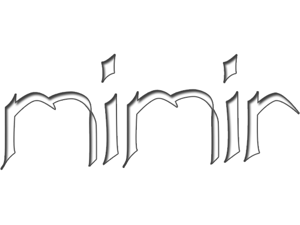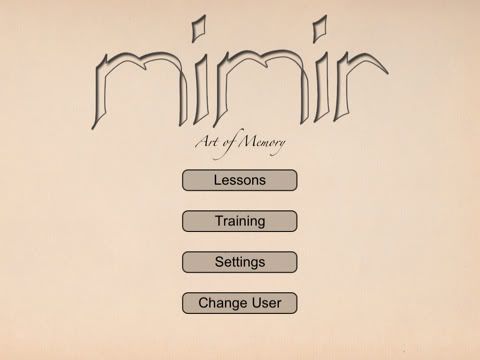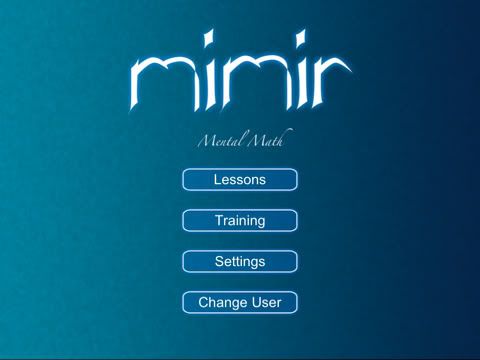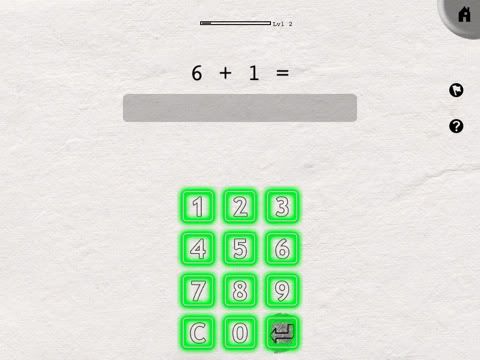 A software company called Snarp recently released two new iOS products, one teaching memory techniques, and the other teaching mental math techniques. This line is called Mimir, after the learned figure in Norse mythology. In this post, we're going to take a look at both of these native iOS apps, which work on the iPhone, iPod Touch, and the iPad.
A software company called Snarp recently released two new iOS products, one teaching memory techniques, and the other teaching mental math techniques. This line is called Mimir, after the learned figure in Norse mythology. In this post, we're going to take a look at both of these native iOS apps, which work on the iPhone, iPod Touch, and the iPad.
Art of Memory
Both the Art of Memory (iTunes Link) and Mental Math apps open by asking you for a user name, a feature that helps if more than one person is using the same iOS device to train. After that, you are taken to the main menu (all screenshots are from the iPad versions, courtesy of Snarp):
Change User is self-explanatory. The settings are simple enough, you can turn the sound on and off, and set the program to run in English or Deutsch (German). Most of the time is spent in the Lessons and Training sections.
Even if you don't know the first thing about memory techniques, Art of Memory is very helpful, and starts you off with a simple introduction. From there on out, each of the remaining 9 lessons are taught in a clear manner, immediately followed by training sessions that help you practice the techniques you just learned.
These training sessions are done with visual images, which helps emphasize how you should envision the objects you're memorizing anyway. The training usually happens in 2 parts. First, you're given the images to memorize, and then you're quizzed on the information. When the training involves more images than are on the screen, the native iOS gestures are supported for moving around the list. This gives the training a very intuitive and friendly feel.
The Training section itself is basically identical to the Lessons section, except with all the written lessons removed, of course. Here's a screenshot of the Object List quiz:

This section of the training starts with 5 images in a row, and as you can see here, you're presented with not only the same images in a different order, but several images that weren't included, as well.
The techniques taught include how to make mental links, and then how to use this to remember lists in and out of order, as well as more specific lessons in the loci system, remembering names and faces, long numbers, foreign words, and even playing cards.
If you're already familiar with the techniques involved, the training portion of the program is a great way to practice and test your skills!
Mental Math
Being part of the same Mimir family, Mental Math (iTunes Link) naturally uses the same basic interface.The first thing you notice about Mental Math, though, is the default background, which is a kind of deep blue pattern that moves like the snow on an empty TV channel. Personally, I found this distracting, and used the settings to easily switch it to the static paper background.

Instead of 10 sections, like Art of Memory, the Mental Math app features 27 different sections! Most of the lessons are on various aspects of multiplication, division, and squaring. There are lessons on addition and subtraction, as well.
Grey Matters readers will be especially interested to know that the final lesson is in determining the day of the week for any date! Interestingly, unlike my lessons, which use the 1900s as the basic century, Mental Math uses the 2000s instead. Those who are learning this for the first time from this app would also be well advised to get the Art of Memory app along with it, to help with the memory requirements.
One major difference between Mental Math and its sister app, Art of Memory, is that the training doesn't take you to a menu, but rather starts you off with the first addition quiz. I'd really like to see this part of the app redesigned with a menu, akin to the one in Art of Memory. Until that time, it's easy enough to get to any quiz you want simply by going through the lessons.
Obviously, with mathematical lessons, you can't employ the rich images as you can with the memory app. However, Snarp still managed to make this app's quiz interface useable and fun by employing a keypad approach. Every time you touch the keypad, a fingerprint appears on it briefly, which is not only a fun touch, but lets you know whether you hit the key you wanted.

One other thing I'd really like to see in a future version of Mental Math is settings for the date quiz, such as being able to set a date range for the years on which you're quizzed. Settings for the difficulty of many of the other sections could also be helpful.
Final Thoughts
I've talked a lot about the downside of Mental Math, but being about a month older than its sister app, Art of Memory, you can see that Snarp learned plenty from their previous app. Also, the quizzes in Mental Math feature a level indicator which is strangely absent from Art of Memory, but would be just as useful in that program.In both apps, the navigation could be greatly improved. Currently, everything assumes that the user is moving forward from lesson to training in the order set up by the developers. Often, the only way to break out of that direction is the house icon in the upper right corner, which asks for verification before letting you proceed.
Also, the fact that this house icon is used for both taking you from an individual page to that section's menu AND to go from a section's menu to the main menu can be a little confusing. The navigation problems could be made much clearer with labeled back and forward arrows, such as those on a browser.
Also, many of the lesson pages in both apps look like they have insufficient instructions merely because it's hard to tell that you need to scroll downward to read more. Something simple like a button, and arrow, or even a simple border could be used to tell the user that there's more text available if they just scroll down the page.
Can I recommend these apps? Yes! The only quibbles I really have with them are a few interface quirks. If you focus on the navigation troubles over the content, you're not going to get as much out of them as you should.
Overall, the lessons are clear, and the quizzes are very helpful. At only $1.99 each, Art of Memory and Mental Math do provide a good value, especially considering that you can learn and practice these skills anywhere you like. I recommend them both.




4 Response to Review: Art of Memory and Mental Math (iOS)
How does "Art of Memory" compare to "Steel Trap"?
Seems to be mixed-reviews for Steel Trap.... Maybe it's one of those either-you-love-it-or-hate-it kinds of things?
Any comparisons, favorable or unfavorable, of these apps with other mnemotechnic-training apps?
J,
Generally, I try to review apps on their own merits, without comparing them to other apps people may or may not have.
Since you specifically asked about Steel Trap, though, here's a quick comparison.
First, Steel Trap focuses entirely on the Journey System of memory, in which you recall things by moving through familiar locations and noting the reminders you've placed at each stop.
Art of Memory, by comparison, focuses on the link, peg, and major systems of memory. I also note there's less assumption of familiarity with memory techniques in Art of Memory.
The lessons in Art of Memory are purely in text, while Steel Trap also offers video instruction. Thanks to the video, Steel Trap does have one very nice touch - World Memory Champion Chester Santos teaching you how to use the Journey System!
The most notable difference, however, is in the testing areas. Steel Trap uses a flashcard-based system, while Art of Memory uses more of a quiz format (as shown in the post above).
Art of Memory and Steel Trap are basically different enough that they can compliment each other quite well, assuming you find the techniques they use quite useful.
There's another app I find quite useful, call Loop & Learn, and you can find my review of it here.
Thank you very much for this great review! It is always great to see that someone actually likes your apps! And it is also very interesting to learn what I should change to make the apps better :-). It can be very difficult to improve programs if you never get any feedback from the users…
I have just released an update to Mimir Mental Math. The flickering blue background was definitely too distracting in the iPad version. It was ok (at least for me) in the iPhone version and I used the same background images (in this case) for the iPad, but because all the images were stretched the noise got too distracting. I changed that in the new version, I hope it is better now.
I also added a short "flashing" of the scrollbar if there is too much text for one screen, that should hopefully solve the problem with the "insufficient instructions". I put the rest of the things you mentioned on my todo-list, I will try to implement as much as possible in future versions of the app. (I also added 4 new lessons and changed a few other things…)
So, thanks again! I hope there will one day be a third part of the Mimir series, but that might take a while (I always have too many projects at the same time)…
Best wishes,
Markus Ruh / Snarp
Thanks for the review! As for me, for mental math
I would prefer the site you mentioned in twitter -doasum.com. (By the way, thanks for sharing). The interface is simple - I guess this is what all mental math apps need.
Post a Comment